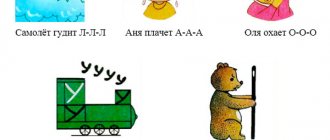Speech readiness of children for school
In order for a child not to experience problems with reading and learning to write, he must have formed certain components of speech, which will be discussed further.
The ability to listen and hear others
If a child does not know how to listen and understand what he hears, then he will have serious problems in understanding the educational material that the teacher tells orally. At this age, it is extremely important that the child can understand and act on the instructions that he receives from the teacher.
Formation of the sound side of speech
The formation of the phonetic side of speech provides for:
- the ability to clearly and distinctly pronounce all speech sounds;
- the ability to change intonation and tempo taking into account the semantic content;
- ability to speak in a whisper, quietly or loudly (depending on the situation).
Severe problems in the sound aspect of speech will certainly affect the child’s performance at school. Children write as they speak, so problems such as omissions or substitutions of letters may appear in their writing.
Ability to distinguish speech sounds by ear
Normally, a child should hear a word and be able to recognize each sound that is part of it (and denote it with a letter on the letter). If some sounds seem the same to him, then this will be reflected in his writing. For example, if a child has difficulty distinguishing between voiced and unvoiced sounds, then instead of the word “house” he will write “tom”, “panan” instead of “banana”.
Language analysis and synthesis functions
The child must not only be able to distinguish all the sounds in a word, but also determine their sequence. The forms of sound analysis are:
- The ability to isolate a sound from the background of a word (“Is there an h sound in the word “barrel”?”). The child’s task is to determine the presence of a sound in a word.
- The ability to identify sounds at the beginning and end of a word (“What sound does the word horse begin with?”, “What sound does the word car end with?”).
- Determining the place of a sound in a word (“Where in the word “caterpillar” is the sound [n] – at the beginning, middle or end?”).
- The ability to name all the sounds in a word in order (sequential analysis).
- Ability to name the number of sounds in a word (quantitative analysis).
In addition to sound analysis and synthesis, an understanding of syllabic and syntactic analysis and synthesis is important.
Syllabic analysis is the ability to divide words into syllables and determine their number in it. The child must be able to form words from the syllables presented to him.
Syntactic analysis is the determination of the number and sequence of words in a sentence. Synthesis is the ability to construct a sentence from the words presented.
Lexicon
A child's readiness for school is determined, in particular, by his vocabulary. As a rule, the vocabulary should be about 3500-4000 words. At the same time, the child must not only know and use these words, but understand their meaning.
At school, the child will have to answer the teacher’s questions, retell texts, and present the material he has studied. He must be able to compose a story based on a picture, write essays on a given topic, etc.
Possible prevention
Speech problems are quite common in children and most of them can be successfully corrected. However, parents can and should make efforts to prevent the occurrence of such problems. You need to constantly talk to your child. From a very early age, children need to hear speech.
When an adult, presumably a mother, clearly pronounces words, comments on all his actions, when a child hears speech addressed to him, a clear pronunciation of sounds, he develops the skill of reproducing not only individual words and sentences, but also a rich palette of intonations, which also has a positive effect on the development of his speech.
It is necessary to contact the child with questions more often, wait for an answer, and provoke him to use an increasingly wider range of words. This must be done even if the child does not have any problems with speech. After all, constant communication affects not only speech, but also general development. At the same time, parents should first of all monitor the correctness of their speech, try to finish phrases and avoid vague formulations.
Preparing for school: how to make sure your child knows how to study
Formation of grammatical structure of speech
By the end of senior preschool age, the child should develop the correct grammatical structure of speech.
The child must be taught:
- correctly coordinate words in a sentence: nouns with numerals and adjectives, pronouns with numerals and adjectives;
- use prepositions correctly and coordinate them with nouns;
- form words with the same root (window - window - little window); form new words from two words (steam - walk - steamer), nouns with suffixes (butter - oil can), verbs with prefixes (go - come), comparative and superlative adjectives (cheerful - more fun - even more fun);
- use indeclinable nouns correctly (cinema, coat, etc.);
- make simple and complex sentences;
- use complex sentences of different types in speech.
Comparison of numbers
A preschool child should be able to compare numbers visually and orally. It’s good if the child can compare both nearby and non-adjacent numbers. For example, six is more than five, and five is less than six; two is less than eight, and eight is more than two.
The child must be able to understand differential comparison of numbers. For example, five is less than six by one, and six is more than five by one.
It is good if the child knows how to obtain equality from inequality or inequality from equality by adding one item to a smaller quantity or removing one item from a larger quantity. For example, five is less than six: if you add one more item to five items, then there will be six items each, that is, equally divided; six is more than five: if you remove one from six objects, then there will be five, i.e. equally.
By this age, children should recognize and understand mathematical signs such as more (>), less (
Geometry
A preschool child should be able to distinguish geometric shapes (circle, square, rectangle, oval, triangle, trapezoid, rhombus), draw them on a sheet of paper, and recognize the shape of familiar geometric shapes in surrounding objects. For example: the sun looks like a circle, a book looks like a rectangle, a road sign looks like a triangle, etc.
It’s good if a preschooler knows how to make one out of two figures. For example: from two to four triangles one is a polygon, from small quadrangles one is large. The child must be able to distinguish geometric bodies, compare them and find differences.
The child must understand that geometric bodies are three-dimensional figures. Among three-dimensional figures, he must distinguish between a sphere, a cube, a cylinder, a cone, and a parallelepiped.
The child must know straight, curved and broken lines. It’s good if he can distinguish between a line, a segment and a ray, right, obtuse and acute angles; can show the vertex and sides of an angle, measure the length of a segment with a ruler, draw a given segment, show the point of intersection of lines.
Problem solving
A preschool child should be able to compose and solve mathematical problems involving addition and subtraction, as well as write down their solutions and know the mathematical signs “+”, “-”, “=”.
It’s good if a preschooler knows how to identify the components of a problem: condition, question, solution, answer; understands that a problem cannot be solved if a condition or question is missing.
By the time a child enters school, he should be able to solve not only problems accompanied by illustrations, but also perceive problems by ear or read the conditions and questions independently.
Number composition
A preschool child should be able to visually form numbers within 10 of units, explain that, for example, 5 is 1, 1, 1, 1 and another 1, or 10 consists of 10 units.
In order for a child to understand what digits a given number consists of, he must be able to decompose it into two smaller numbers (to begin with, within 10 and on a visual basis) and make a larger number from two smaller ones. For example: the number 8 consists of 4 and 4 or 3 and 5; and, conversely, the numbers 5 and 5 make up the number 10. The child should be able to determine the missing component number. For example, the number 7 consists of 4 and...? The child must name the number 3.
It’s good if the baby can make numbers within 20. And within 100, it will be enough for him to be able to make numbers in tens. For example: 60 consists of six tens, etc.
Solving Examples
A preschool child should be able to solve examples of addition and subtraction within twenty, as well as within a hundred by tens. It’s good if a child can make mental calculations within the first ten, without relying on visual material. The child can solve more complex examples within the second ten using counting sticks or other counting material.
A preschooler must know and be able to write mathematical signs “+”, “-”, “=”; distinguish and name arithmetic operations - “addition” and “subtraction”; independently write down examples under dictation from an adult.
Logic problems
The development of logical thinking is one of the important conditions for a child’s successful learning of mathematics. In this section you will find several types of logic problems that are usually given to future first-graders during school testing.
A preschool child should be able to solve entertaining problems with mathematical meaning. Some problems are solved using arithmetic operations, others - using logical thinking.
Logical thinking tasks encourage the child to think, reason, analyze, and establish connections between phenomena.
Neurotic conditions - special attention
Speech problems may be the result of some neurotic disorders. It is necessary to carefully monitor the child: whether his emotional state (joy, anger, fear) is reflected in the speech process.
It happens that a child, overexcited, tries to say something, but fails. He starts saying the phrase over and over again and gets confused. At such moments, you need to stop him, ask him to take a deep breath several times, calm down and clearly pronounce the phrase he was going to say.
If these moments are missed, stuttering may develop, which will have to be treated later. If your child constantly has difficulties “due to nervousness,” then before going to a speech therapist, you should consult a neurologist.
Do you think that the introduction of a compulsory second foreign language from the 5th grade will have a positive impact on the quality of knowledge of schoolchildren?







